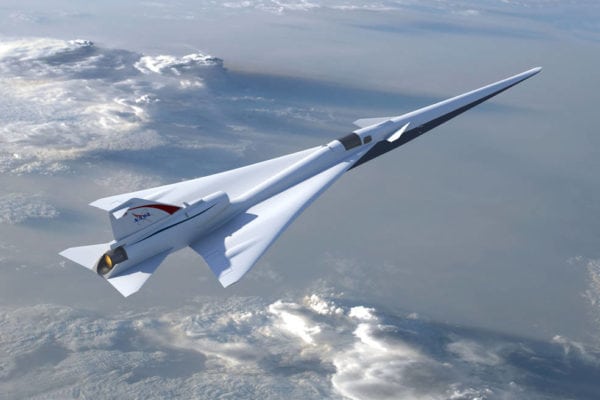
Illustration of NASA’s planned Low Boom Flight Demonstration aircraft as outlined during the project’s preliminary design review. Photo courtesy of NASA / Lockheed Martin
As OEMs work on new supersonic airframes, one of the world’s largest avionics manufacturers and NASA have completed testing a key technology that could help make commercial supersonic travel a reality. Testing on a new avionics technology designed to help pilots predict where a sonic boom would occur over land has been completed. Now, the next hurdle is developing a clear path to certification and proving that current regulations on air travel speed over land can be removed.
In June, NASA and Honeywell completed a two-year test that integrated predictive software and cockpit display technology on a business jet cockpit. The test demonstrated how pilots can use display technology to predict where and how sonic booms generated by business jets flying faster than the speed of sound will impact populated areas on the ground within their flight path.
The test used a Dassault Falcon 900 business jet owned by Honeywell, featuring a Primus Epic avionics package. Honeywell engineers updated the avionics with new software designed to predict the impact of a sonic boom on the ground, based on the Falcon 900’s position and flight parameters. While the test flights did not actually fly at supersonic speed, the demonstration did simulate supersonic travel in real airspace using real interaction with flight dispatchers and air traffic controllers.
This was the first such testing that occurred in real airspace, compared to similar tests performed in restricted airspace before near NASA’s Armstrong facility. The Dassault Falcon 900 test flights occurred near Honeywell’s Deer Valley facility in an environment that simulated what real commercial supersonic travel over land in the future would look like.
“The testing used our Primus Epic suite. That integrated avionics suite has been deployed on many different corporate jet airframes. The idea is that we would be able to deploy this fairly simply once we know what the regulations are and then demonstrate how to satisfy them,” Olu Olofinboba, senior manager for advanced technology at Honeywell Aerospace told Avionics.
Beyond the display, the software also pulls information from the Primus Epic flight management system. Olofinboba also said population databases can provide pilots with information on what areas over which to avoid flying.
The testing did not test any technology capable of providing real-time updates as to where people on the ground are when conducting a supersonic flight over land. Currently, that’s not a capability that is realistically simulated, according to Olofinboba.
The two-year test period provided Honeywell and NASA, as well as the aviation industry, with the concept of how supersonic travel could work in the future. Now that the software has been tested using a Primus Epic avionics suite, similar avionics packages could be updated with the sonic boom pilot interfacing technology. However, that all depends on standards and certification guidelines being developed in the future.
Honeywell has also been active elsewhere supporting companies that are trying to make commercial supersonic flying a reality in the near future. Denver, Colorado-based OEM Boom is using Honeywell avionics in its XB-1 demonstrator aircraft, which is scheduled to start flying its first subsonic tests next year. At the 2017 Paris Air Show, Boom announced orders for 76 total aircraft.
The next step for Honeywell and NASA will be to start testing its low boom flight demonstration experimental aircraft, better known as an X-plane. NASA said at the end of June it has completed the preliminary design review of its Quiet Supersonic Transport (QueSST). The mission objective for the low boom flight demonstration X-plane is to fly at supersonic speeds while generating a “soft bump,” instead of a sonic boom, according NASA.
NASA has not set an official date for flight testing to begin with QueSST, though the agency says it could begin as early as 2021. QueSST preliminary design data is being made available to the public, with NASA expressing the desire to make it open and competitive.